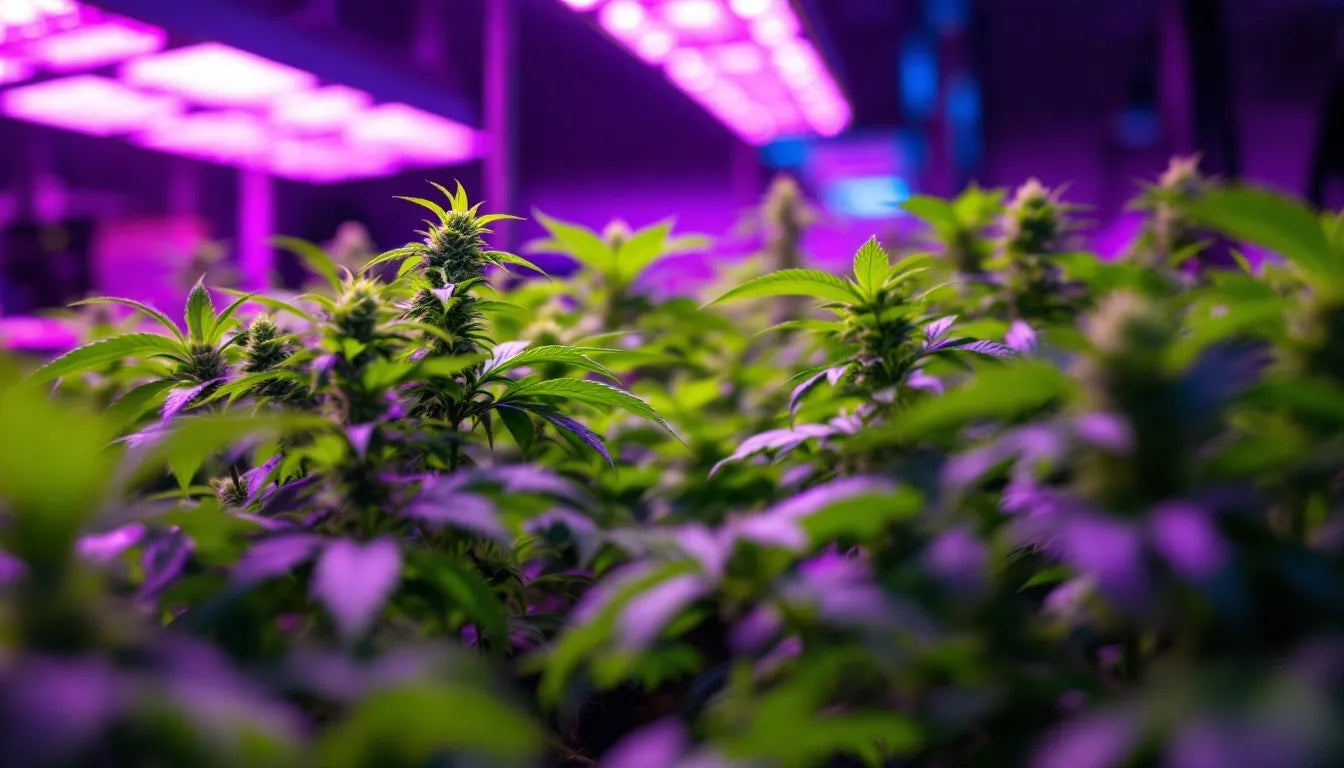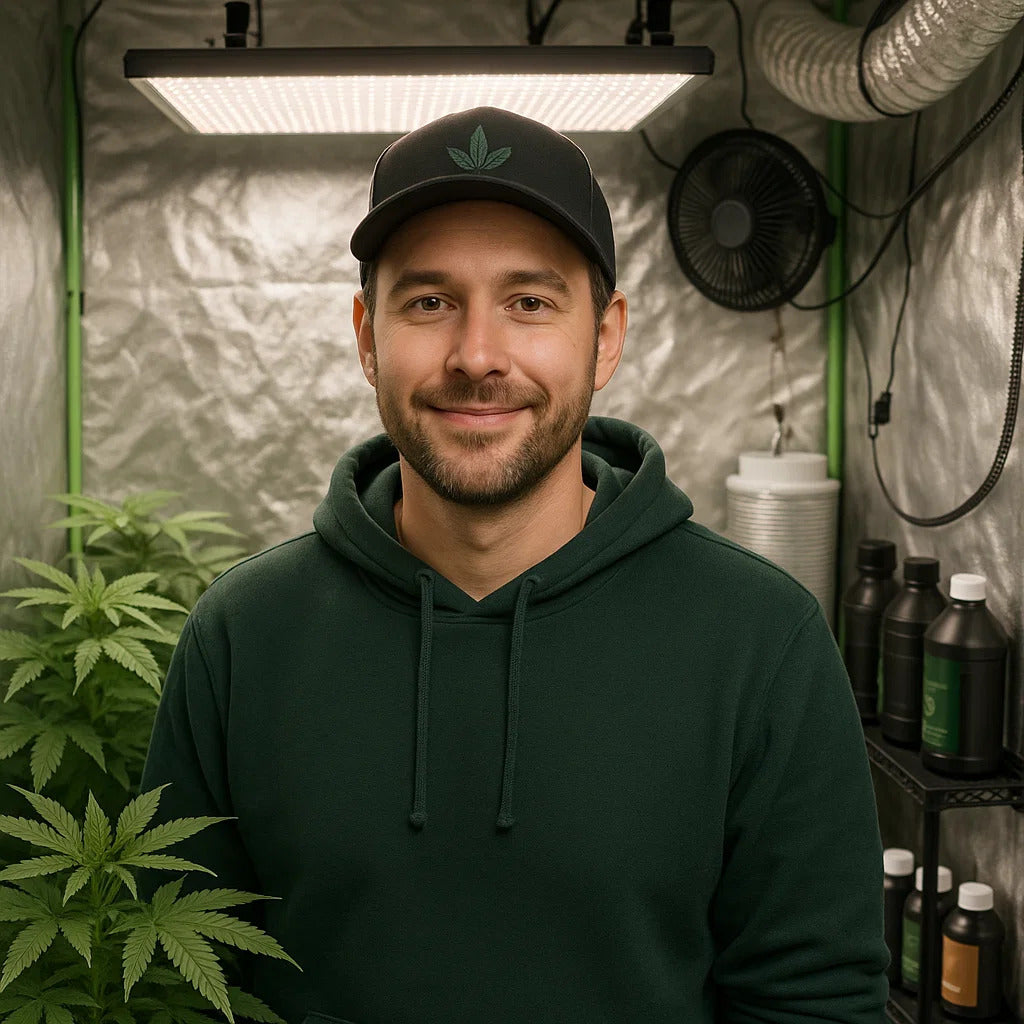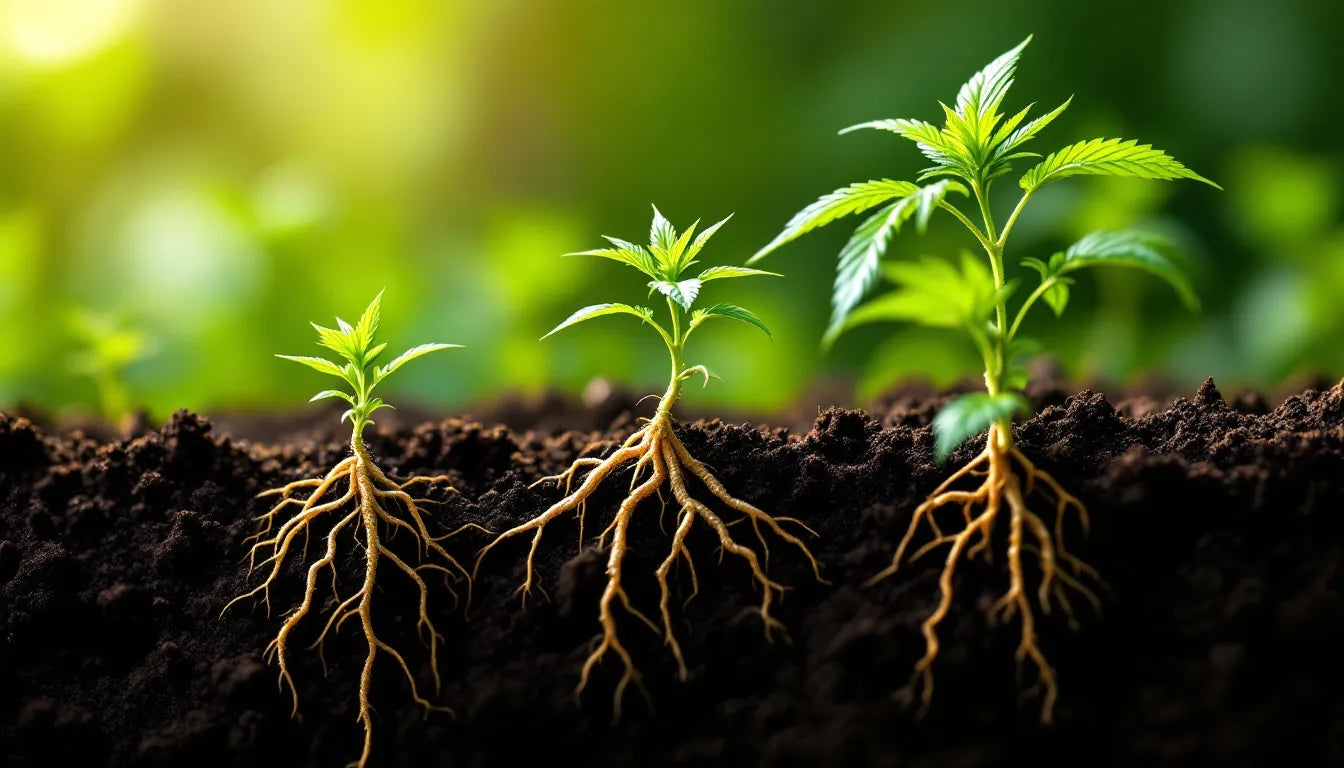
How to Grow Hydroponic Weed: Complete Guide to Soilless Cannabis Cultivation
Hydroponic cannabis cultivation offers faster growth rates, higher yields, and complete control over plant nutrition compared to traditional soil growing. By delivering nutrients directly to roots through water-based solutions, hydroponic systems can reduce growing times by 20-30% while producing exceptional quality buds.
This comprehensive guide covers everything you need to know about growing cannabis hydroponically, from choosing the right system to managing nutrients and pH levels. Whether you're upgrading from soil or starting fresh, hydroponic growing provides unmatched control over your plants' development.
Important Note: Only cultivate cannabis where legally permitted. Always verify local laws before beginning any growing operation.
Why Choose Hydroponic Cannabis Growing?
Faster Growth and Higher Yields
Hydroponic systems deliver nutrients directly to root zones in perfect ratios, eliminating the time plants spend searching for nutrients in soil. This direct feeding can accelerate vegetative growth by 25-40% compared to soil cultivation.
Plants grown hydroponically often produce 20-50% higher yields than their soil-grown counterparts when properly managed. The precise control over nutrition allows plants to reach their full genetic potential consistently.
Professional grow tent systems provide the controlled environment essential for maximizing hydroponic growing advantages, ensuring optimal conditions throughout the entire growing cycle.
Complete Environmental Control
Hydroponic growing eliminates soil-borne pests, diseases, and pH fluctuations that can stress plants and reduce yields. You control every aspect of plant nutrition with precision impossible in soil-based systems.
Root zone management becomes much more precise, allowing you to adjust nutrient concentrations, pH levels, and oxygen availability in real-time based on plant development stages and needs.
Water and Nutrient Efficiency
Despite common misconceptions, properly managed hydroponic systems use less water than soil growing. Recirculating systems reuse nutrient solutions multiple times, minimizing waste while maintaining optimal nutrition levels.
Advanced nutrient systems designed for hydroponics provide complete plant nutrition in easily manageable formulations that eliminate guesswork from feeding schedules.

Types of Hydroponic Systems
Deep Water Culture (DWC)
Deep Water Culture suspends plant roots directly in oxygenated nutrient solutions. This system offers simplicity, fast growth rates, and easy maintenance, making it excellent for beginners.
DWC systems require air pumps and air stones to provide oxygen to submerged roots. Without adequate oxygenation, roots quickly develop rot and other problems that can kill plants rapidly.
5x5 grow tents provide ideal spaces for DWC setups, offering room for multiple buckets while maintaining environmental control necessary for optimal hydroponic growing.
Nutrient Film Technique (NFT)
NFT systems use shallow channels with gentle nutrient solution flow past plant roots. This technique provides excellent oxygenation while maintaining constant nutrient availability to developing root systems.
NFT works exceptionally well for smaller plants and sea-of-green growing methods. The system requires precise leveling and consistent pump operation to prevent dry spots or flooding.
Ebb and Flow (Flood and Drain)
Ebb and flow systems periodically flood growing containers with nutrient solution, then drain back to a reservoir. This cycling provides nutrients while allowing roots to access oxygen between flood cycles.
These systems offer excellent flexibility for different container sizes and growing media options. They're more forgiving than constant-flow systems if equipment temporarily fails.
Drip Systems
Drip irrigation delivers precise amounts of nutrient solution directly to each plant's root zone through individual emitters. This method provides excellent control over individual plant feeding while conserving nutrients.
Professional growing setups often incorporate drip systems for their precision and ability to handle multiple plants with varying nutritional needs efficiently.
Aeroponic Systems
Aeroponics suspends roots in air while misting them with nutrient solutions. This advanced technique provides maximum oxygenation and can produce incredibly fast growth rates when properly managed.
Aeroponic systems require more technical knowledge and equipment redundancy but can produce the fastest growth and highest yields of any hydroponic method.
Essential Equipment for Hydroponic Growing
Grow Tent and Environmental Control
Quality grow tents provide the controlled environment essential for hydroponic success. Environmental stability becomes even more critical with hydroponic systems since plants have no soil buffer against rapid changes.
Temperature fluctuations, humidity swings, and inadequate ventilation can cause rapid nutrient solution problems that stress plants within hours rather than days.
Professional ventilation systems maintain optimal air exchange rates while preventing humidity buildup that can cause root rot and other hydroponic-specific problems.
Lighting for Hydroponic Systems
LED grow lights work exceptionally well with hydroponic setups due to their lower heat output and precise spectrum control. Heat management becomes critical since nutrient solutions can warm quickly under intense lighting.
Full-spectrum LEDs provide optimal light wavelengths throughout all growth stages while generating minimal heat that could raise nutrient solution temperatures to harmful levels.
Pumps and Air Systems
Water pumps circulate nutrient solutions through your chosen hydroponic system. Size pumps appropriately for your system volume and head height requirements to ensure adequate flow rates.
Air pumps and air stones provide essential root oxygenation, particularly critical in DWC systems where roots remain constantly submerged in nutrient solutions.
Reservoirs and Storage
Nutrient reservoirs should hold 2-4 times your system's daily water consumption to maintain stable pH and nutrient levels. Larger reservoirs provide better stability and require less frequent monitoring.
Complete hydroponic kits include properly sized reservoirs and all necessary equipment for successful hydroponic cultivation from day one.
Growing Media for Hydroponics
Rockwool
Rockwool provides excellent water retention and aeration for hydroponic growing. It's sterile, pH-neutral after preparation, and provides stable support for developing root systems.
Pre-soak rockwool in pH 5.5 water for 24 hours before use to remove manufacturing residues and adjust pH to optimal levels for cannabis cultivation.
Hydroton Clay Pebbles
Expanded clay pebbles offer superior drainage and aeration while providing good root support. They're reusable after proper cleaning and sterilization between grows.
Clay pebbles work excellently in ebb and flow systems and as top dressing in other hydroponic media to improve surface drainage and reduce algae growth.
Perlite and Vermiculite
Perlite provides excellent drainage and aeration, while vermiculite offers superior water retention. Mixing these media creates customizable drainage and retention characteristics for different growing needs.
Coco Coir for Hydroponics
Coco coir offers excellent water retention with good aeration when properly prepared. It provides a more soil-like growing experience while maintaining hydroponic precision and control.
Cal-Mag supplements become essential when using coco coir due to its calcium and magnesium binding characteristics that can create deficiencies.

Hydroponic Nutrients and Feeding
Understanding NPK Ratios
Hydroponic nutrients provide precise control over nitrogen (N), phosphorus (P), and potassium (K) ratios throughout different growth stages. Vegetative growth requires higher nitrogen ratios, while flowering demands increased phosphorus and potassium.
Professional hydroponic nutrients are specifically formulated for cannabis cultivation, providing optimal ratios for each growth stage without complicated mixing calculations.
Base Nutrients vs Supplements
Base nutrients provide primary NPK nutrition plus essential secondary nutrients and micronutrients. Supplements address specific needs like calcium/magnesium, root development, or flowering enhancement.
Start with complete base nutrient systems before adding supplements. Many beginning hydroponic growers over-supplement, creating nutrient imbalances that harm rather than help plant development.
Feeding Schedules and Concentrations
Begin with nutrient concentrations at 25-50% of manufacturer recommendations, gradually increasing based on plant response. Young plants and seedlings require much lower concentrations than mature flowering plants.
Monitor electrical conductivity (EC) or total dissolved solids (TDS) to track nutrient solution strength accurately. EC meters provide more reliable measurements than TDS meters for hydroponic applications.
Nutrient Solution Management
Change complete nutrient solutions every 1-2 weeks to prevent nutrient imbalances and salt buildup. Top off daily water losses with plain pH-adjusted water between complete changes.
Track nutrient consumption patterns to optimize feeding schedules and concentrations. Plants in different growth stages consume nutrients at varying rates requiring solution adjustments.
pH Management in Hydroponics
Understanding pH Importance
Cannabis grows best in slightly acidic hydroponic solutions with pH between 5.5-6.5. Optimal pH allows maximum nutrient uptake while preventing nutrient lockout that can severely impact plant health.
pH levels outside the optimal range prevent nutrient absorption even when solutions contain adequate nutrition. This creates deficiency symptoms despite proper feeding concentrations.
pH Testing and Adjustment
Digital pH meters provide accurate readings essential for hydroponic success. Calibrate meters regularly using standard buffer solutions to maintain measurement accuracy over time.
pH adjustment solutions (pH Up and pH Down) allow precise control over solution acidity. Add adjustments gradually and mix thoroughly before retesting to prevent overshooting target pH levels.
pH Drift and Stability
Healthy root systems naturally affect pH levels as they uptake nutrients and release organic compounds. Expect gradual pH changes requiring daily monitoring and adjustment.
Quality growing systems include pH monitoring equipment and adjustment supplies as essential components rather than optional accessories.
Water Quality and Preparation
Starting Water Quality
Begin with low-mineral water sources when possible. Reverse osmosis (RO) water provides the cleanest base for hydroponic nutrients, eliminating unknown minerals that can interfere with feeding programs.
Tap water quality varies dramatically by location. Test your water source for pH, hardness, and dissolved minerals before use to understand what adjustments may be necessary.
Water Temperature Management
Maintain nutrient solution temperatures between 65-75°F (18-24°C) for optimal root health and nutrient uptake. Higher temperatures reduce dissolved oxygen levels and promote harmful bacteria growth.
Cooler water holds more dissolved oxygen, benefiting root development and overall plant health. Water chillers become necessary in hot climates or under intense lighting conditions.
Dissolved Oxygen Levels
Adequate dissolved oxygen prevents root rot and promotes healthy root development. Air stones, venturi valves, or waterfalls can increase oxygen levels in nutrient solutions.
Monitor dissolved oxygen levels, particularly in DWC systems where roots remain constantly submerged. Low oxygen levels quickly lead to root problems and plant death.
Environmental Control for Hydroponic Growing
Temperature and Humidity Management
Hydroponic systems create higher humidity levels due to increased water evaporation from nutrient solutions and faster plant transpiration rates. Enhanced dehumidification becomes essential, particularly during flowering.
Professional climate control equipment maintains optimal growing conditions while preventing humidity-related problems like mold and mildew that can devastate hydroponic crops.
Air Circulation and Ventilation
Strong air circulation prevents stagnant conditions that promote algae growth in nutrient solutions and reduce plant transpiration rates. Oscillating fans provide beneficial air movement throughout the growing space.
Enhanced ventilation removes excess humidity while providing fresh CO2 for photosynthesis. Hydroponic plants often consume CO2 faster than soil-grown plants due to accelerated growth rates.
Light Management
Position lights to provide even coverage while minimizing heat buildup that can warm nutrient solutions. LED lighting systems offer precise spectrum control with minimal heat generation ideal for hydroponic applications.
Monitor canopy temperatures closely, as hydroponic plants can be more sensitive to light burn due to their accelerated growth and higher metabolic rates.
Common Hydroponic Problems and Solutions
Root Rot Prevention and Treatment
Root rot appears as brown, mushy roots with foul odors and typically results from inadequate oxygenation, high water temperatures, or contaminated nutrient solutions.
Prevent root rot through proper oxygenation, clean reservoirs, and optimal water temperatures. Treatment requires removing affected roots, sterilizing systems, and improving growing conditions.
Nutrient Deficiencies and Toxicities
Hydroponic systems can show nutrient problems more rapidly than soil due to direct root contact with nutrient solutions. Monitor plants daily for early signs of nutritional imbalances.
Balanced nutrition programs prevent most common deficiencies while providing all essential nutrients in proper ratios for healthy plant development.
pH and EC Fluctuations
Rapid pH or EC changes indicate system problems requiring immediate attention. Large fluctuations can shock plants and severely impact growth rates and final yields.
Maintain detailed logs of pH and EC measurements to identify patterns and potential problems before they severely impact plant health and development.
Algae Growth Control
Algae growth in nutrient solutions competes with plants for nutrition while potentially clogging system components. Prevent algae through light-proof reservoirs and system cleanliness.
Remove algae immediately when detected and identify the light source allowing growth. Hydrogen peroxide can eliminate existing algae without harming plants when used properly.
Growth Stages in Hydroponic Systems
Seedling Care in Hydroponics
Start seedlings in rockwool cubes with very weak nutrient solutions (EC 0.6-0.8). Young roots are extremely sensitive to high nutrient concentrations that can burn and kill developing plants.
Maintain higher humidity around seedlings while ensuring adequate air circulation to prevent damping-off diseases that quickly kill young hydroponic plants.
Vegetative Growth Optimization
Increase nutrient concentrations gradually as plants develop larger root systems capable of handling stronger solutions. Vegetative plants can typically handle EC levels between 1.2-1.8.
Advanced training techniques work exceptionally well with hydroponic systems due to faster recovery times and accelerated growth rates from precise nutrition.
Flowering Stage Management
Transition to flowering nutrients with reduced nitrogen and increased phosphorus and potassium. Lower humidity levels become critical during flowering to prevent bud rot and mold development.
Monitor plants closely during early flowering stretch as rapid growth can quickly outpace available space in indoor growing environments.
Advanced Hydroponic Techniques
Sea of Green (SOG) Method
SOG techniques work excellently with hydroponic systems, allowing numerous small plants to fill growing spaces efficiently. This method maximizes yields while minimizing vegetative growth time.
Compact growing spaces work perfectly for SOG methods, providing environmental control while accommodating multiple small plants in efficient arrangements.
Screen of Green (SCROG) Training
SCROG techniques combined with hydroponic growing can produce exceptional yields from single plants. The accelerated growth from hydroponic nutrition supports aggressive training methods.
Install SCROG screens during early vegetative growth, training branches through screen openings as plants develop to create even canopies for maximum light penetration.
Perpetual Growing Systems
Hydroponic systems excel in perpetual growing setups where plants in different growth stages share growing spaces. Separate nutrition systems allow precise feeding for each development stage.
Multiple tent systems enable sophisticated perpetual harvests with optimal conditions for each growth stage without compromise.
Harvesting and Processing Hydroponic Cannabis
Determining Harvest Timing
Hydroponic plants often finish flowering 1-2 weeks faster than soil-grown plants due to optimal nutrition and growing conditions. Monitor trichomes closely to ensure optimal harvest timing.
Use jeweler's loupes or digital microscopes to examine trichomes for harvest readiness. Clear trichomes indicate early harvest, cloudy shows peak potency, and amber suggests increased sedative effects.
Pre-Harvest Flushing
Flush hydroponic systems with plain pH-adjusted water for 1-2 weeks before harvest to remove residual nutrients and improve final product smoothness and flavor.
Monitor plant response during flushing, as hydroponic plants may show deficiency symptoms more quickly than soil-grown plants due to immediate nutrient cessation.
Drying Hydroponic Buds
Proper drying equipment becomes essential for hydroponic harvests, which may contain higher moisture levels requiring careful environmental control during processing.
Maintain drying temperatures around 60-65°F (15-18°C) with humidity levels of 45-55% for optimal preservation of potency and terpene profiles developed through precise hydroponic cultivation.

FAQ Section
Is hydroponic weed stronger than soil-grown? Hydroponic cultivation can produce higher THC levels due to precise nutrition and optimal growing conditions, but genetics ultimately determine maximum potency potential. Quality hydroponic systems consistently reach genetic potential.
How much faster does hydroponic weed grow? Hydroponic cannabis typically grows 20-30% faster than soil-grown plants due to direct nutrient delivery and optimal root conditions. Vegetative stages can be shortened by 1-3 weeks compared to soil cultivation.
What's the best hydroponic system for beginners? Deep Water Culture (DWC) offers simplicity and fast results for beginners, while drip systems provide more forgiving operation. Start with simple systems before advancing to complex setups like aeroponics.
How often should I change hydroponic nutrients? Complete nutrient solution changes every 1-2 weeks prevent imbalances and maintain optimal plant nutrition. Top off daily with plain pH-adjusted water between complete changes.
What pH should hydroponic cannabis be? Maintain hydroponic nutrient solution pH between 5.5-6.5 for optimal nutrient uptake. Cannabis prefers slightly acidic conditions for maximum nutrient availability and absorption.
Quick Hydroponic Summary
Hydroponic cannabis cultivation offers faster growth, higher yields, and precise control over plant nutrition compared to soil growing. Success requires attention to pH management, nutrient concentrations, and environmental control.
Start with simple systems like DWC before advancing to complex methods. Quality equipment and consistent monitoring ensure hydroponic growing success from your first attempt.
Ready to start hydroponic growing? Explore our complete selection of professional grow tent systems designed for successful hydroponic cultivation. Our environmental control equipment provides the precision needed for hydroponic success. Check our latest deals to get started with equipment optimized for soilless cultivation.

Lena Myles
I'm a mushroom enthusiast and home cook based in Oregon. I'm passionate about foraging and creating fungi-focused recipes, especially delicious, plant-based dishes using gourmet mushrooms like trumpet, shiitake, and oyster. When I’m not in the kitchen, you’ll usually find me wandering the woods in search of new wild flavors.


